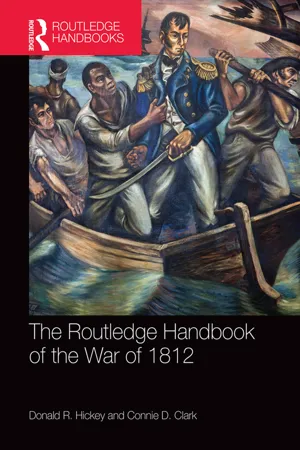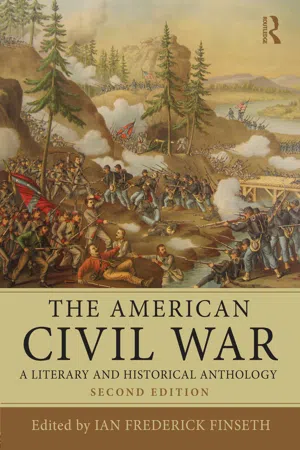History
American Homefront
The American Homefront refers to the social, economic, and political conditions in the United States during World War II. It was a time of great change as women entered the workforce in large numbers, rationing was implemented, and the government took on a greater role in the lives of citizens. The Homefront played a crucial role in supporting the war effort and ultimately contributed to the Allied victory.
Written by Perlego with AI-assistance
Related key terms
6 Key excerpts on "American Homefront"
- eBook - ePub
- Donald R. Hickey, Connie D. Clark(Authors)
- 2015(Publication Date)
- Routledge(Publisher)
11The American Home Front, 1812–1815J.C.A. StaggWhat do historians speak of when they describe the “home front” during a war? There are several ways in which this question might be approached and they are not always compatible. Many scholars separate accounts of civilian life during wartime from the narratives of military campaigns; they assume that the former did not necessarily impact the latter. From this vantage point, studies of the home front can embrace a wide variety of phenomena that cannot be categorized clearly as the history of combat. Other writers, drawing on recent developments in the fields of military and social history, have dissolved this distinction by stressing the permeability of the military and civilian spheres; they maintain that the two constantly interact and cannot be meaningfully separated. Pushed to its logical conclusion, this approach has given rise to the notion of “transformational” war, conflicts in which the demands of mobilization and battle can be so great that they inexorably reshape pre- war patterns of culture, economic activity, politics, and social structure in ways that produce significant and long- lasting change.How might the War of 1812 be understood from these perspectives?At first sight, it could be surmised that because the war was of relatively short duration (32 months) and because mobilization seemed neither extensive nor effective—contemporary counts found little more than 34,000 men in the U.S. Army by 1815 from a population of just over 8 million—that the lives of the vast majority of the citizenry were unaffected. Most people experienced the war vicariously, either by reading newspapers and pamphlets or by hearing word- of- mouth accounts of its events; otherwise they pursued their daily routines on farms, in workshops, and on the waterfronts with only occasional disruptions. Such a conclusion, however, risks ignoring what we have learned from the “new military history,” most notably the awareness that mobilization and campaigning should not be considered apart from the social, cultural, and political characteristics of the people who were called upon to shoulder the burdens of war. - eBook - ePub
A Letter from Grosvenor Square
An Account of a Stewardship
- John Gilbert Winant(Author)
- 2018(Publication Date)
- Arcole Publishing(Publisher)
British Home Front
WAR today is not a conflict between armed forces drawing on a home base—it is a death fight between entire nations, each reaching out to destroy the manpower and the resources of the other. We saw that in bombed Britain, in the destruction of Germany and, in the end, in the obliteration of Hiroshima. There were fewer men killed in battle in this war than in the last, but more women and children. Each successive war reaches deeper into the civil population and necessitates the organization of home fronts as well as battle fronts. We were spared attack on our home base this last war. No one can hope that this will be true if war comes again. I have, therefore, described in detail the organization of the civil population in Great Britain.Because their house was in order, they were not only able to hold at bay the enemy which had overrun Europe, they were able, with the aid we sent them, to build a firm springboard for us to cross the Channel with them and smash the Axis armies on the Western Front. We did not find a war-weary people, but a taut, disciplined, alert nation restless to be at the enemy.It is not enough for those who love peace to talk peace. A lover of peace must understand war—its causes and its course. It is not enough to hope. We must also work desperately on practical measures that sometimes seem far short of our dreams.Always the urgency of the military situation was reflected in the measures taken on the British Home Front. I tried, in my reports, to give some idea of the interrelationships between the various measures adopted in regard to labor, taxation, finance, manufacturing industries, and service occupations, as well as food, nutrition, and social welfare.But it is impossible to describe the Home Front without thinking in terms of people and organization. The co-ordination of the civil activities came under Sir John Anderson, member of the War Cabinet and Lord President of the Council. He was an Independent Member elected to Parliament by the Scottish Universities. He had spent his life as a British civil servant and had great gifts as an administrator. His ability in integrating the skill of the expert, whether scientist, engineer, or economist, without disturbing the efficiency of routine controls, permitted the maximum contribution by the expert, and the full authoritative drive of officials responsible for purely administrative activities. There was no duplication or waste of brains or energy in the functioning of his overall planning. Mr. Churchill referred to him as the “Home Front Prime Minister.” He was tough and hard-working, patient and sagacious. Nor did he give the impression of being endowed with more than average ability—a nice trait in a man who can afford it. - eBook - ePub
- David M. Kennedy, David M. Kennedy(Authors)
- 2007(Publication Date)
- Simon & Schuster(Publisher)
11W AR
ON THE HOME FRONTT he American people…are fighting this war wholeheartedly—with less flag-waving and fanfare than we had in World War I, but with more unanimity and with a clearer purpose,” wrote Selden Menefee in 1943. Menefee had been commissioned by the Office of Public Opinion Research at Princeton University to travel 15,000 miles throughout the United States to record his observations of the American home front. In Virginiahemet “a sixteen-year-old boy…who quit high school to work as ariveter’s helper in a sheet metal shop…for 70 cents an hour seven days a week.” Near Natchez, Mississippi, he passed “a tiny plantation cabin…with five service stars in the window”—one for each of its sons in the military. In Vermont, he spoke with “a teller in the local bank…who works four hours every night running a machine in one of three small factories,” in the same town where four hundred women had volunteered for the Red Cross, “turning out surgical dressings,…and…making kit bags for soldier sand clothing for bombed out British families.” Menefee also visited “the first Iowa county to oversubscribe its $817,200 war bond quota in 1942,” and watched “a boisterous and excited carload of WACS on their way from Texas to Des Moines to be inducted.”Enlistments and bond drives, victory gardens and scrap collections, factories working at peak production, volunteers at a soldiers’ canteen—these convey the spirit of energy and cooperation, the positive outlook and spunky, can-do attitude that is popularly associated with the American home front of World War II. The United States had preserved its constitutional structure through years of economic hardship during the Great Depression. In 1940, columnist Dorothy Thompson could write, “Here we are, and our basic institutions are still intact, our people relatively prosperous.” After the country entered the war in December 1941, the revving up of the economy brought previously unimaginable prosperity to the average American. (See also Chapter 3.) - eBook - ePub
America and Its Sources
A Guided Journey through Key Documents, 1865-present
- Erin L. Conlin, Stephan Schaffrath, Erin L. Conlin, Stephan Schaffrath, Erin L. Conlin, Stephan Schaffrath(Authors)
- 2019(Publication Date)
- Milestone Documents(Publisher)
7.1 World War II and the Home FrontOverviewWorld War II was a major turning point in U.S. history and the world. It caused global turmoil and disrupted the lives of millions of people. This unit specifically examines the war and the home front in order to focus attention on how it directly affected the United States.The last unit explored the Great Depression, including its impact on Americans and government efforts to help people suffering as a result of it. President Franklin D. Roosevelt tried countless policies and programs aimed at ending the Depression. Many helped to mitigate the worst effects of the Depression, but most scholars agree World War II was responsible for bringing it to a close. The reasons for this are similar to what you read about during World War I. Large numbers of men (and increasingly women) left the workforce to join the military. At the same time, the United States increased its industrial production and food supply. Initially, it did this in a limited quantity to support its allies. Following the Japanese attack on Pearl Harbor in December 1941 and the United States’ declaration of war, however, the nation dramatically increased production. This required more workers in virtually all sectors of the economy.American workers began shifting jobs looking for better opportunities. For example, agricultural workers often left farm work looking for better paying industrial jobs. In extreme cases this left labor shortages resulting in U.S. farmers demanding access to foreign workers to tend their crops. The United States government brought in workers from Mexico, under the Bracero Program, as well as people from the Bahamas and the Caribbean under the British West Indian Emergency Farm Labor Program. In both instances workers were imported to work temporarily, and then they returned to their native countries at the close of the harvest season. This program provided migrant workers with the opportunity to earn higher wages than they often could at home, but it came at a cost. Working conditions were often poor and laborers had little recourse, since they could easily be deported for complaining about wages or conditions. Additionally, by importing workers, farm owners made it more difficult for domestic workers to push for better wages and conditions because they could be replaced by the foreign workers. - eBook - ePub
The Home Front in Britain
Images, Myths and Forgotten Experiences since 1914
- Janis Lomas, M. Andrews(Authors)
- 2014(Publication Date)
- Palgrave Macmillan(Publisher)
Not only were civilians much more diverse than is commonly recognised, as photographs of street scenes from the war remind us, but the Home Front also evolved and changed over the duration of the war. This is particularly apparent from the close study of local newspapers which enable the mapping of how everyday life was sustained in a changing and unpredictable context. This was the first experience of ‘total war’ in Britain and at each level of society and in every mundane corner of life the war brought challenges for which people were unprepared and had to improvise solutions. Although the war economy was necessarily more centralised than its peacetime equivalent, the Home Front could only succeed if it was made to work in local communities and in daily life. The housewife was an important part of this. Highlighting the housewife within the First World War story underscores the importance of the Home Front to the prosecution of the war. Food was a weapon of war, wielded in everyday life not by national government but by housewives in their kitchens and in food queues, shops and market places. Germany and Britain’s naval blockades were designed to break civilian morale as feeding a civilian population (including its armament workers) in addition to the army would stretch the wartime economy to breaking point. In ‘total war’ civilian morale could not be ignored. Food riots could bring down governments. Moreover, the extraordinary volume of post exchanged between home and war front, meant that military morale could be seriously threatened by news of hardship and even hunger in the family that the soldier believed himself to be fighting for. 59 The kitchen really was ‘the Key to Victory. Looking for the First World War housewife should also make us more critical about which voices we hear when we examine the ‘Great War experience’ - eBook - ePub
The American Civil War
A Literary and Historical Anthology
- Ian Frederick Finseth, Ian Frederick Finseth(Authors)
- 2020(Publication Date)
- Routledge(Publisher)
IVThe Home FrontHome again. Lithograph by Endicott & Co., 1866. Library of Congress Prints and Photographs Division, LC-DIG-pga-01172Introduction
Because it was fought entirely on American soil, and because it absorbed the full energies of both North and South, the Civil War affected civilian life in far-reaching ways. Every state had an economic and political stake in the conflict; every state sent soldiers into the fray; and millions of families found their lives directly affected by events both near and far. In contrast to America’s foreign wars, civilians participated and suffered in the Civil War in ways that few could have anticipated. The civilian experience in the Civil War entailed an array of changes—some minor and some major, some short- I ived and some long-lasting—in both daily life and the broader framework of cultural attitudes that Americans had traditionally brought to their work, their homes, and their social relations.Most directly, the war effort affected civilians by turning some of them into combatants— not always with their consent. As it became clear that the initial call-up of voluntary enlistments in 1861 would not suffice, both militaries turned to other means of recruitment, the most prominent being conscription (or the threat of conscription) and bounties (i.e., direct payments to new enlistees). By the end of the war, more than 3 million Americans, or about 10 percent of the total population, had fought. These soldiers represented a broad swath of the American public. The vast majority were native-born white men in their twenties and thirties, although immigrants made up about a quarter of the Union army and about 10 percent of the Confederate army. About half of the North’s soldiers were farmers or farm laborers, compared to about two-thirds of Southern soldiers, while the rest hailed from a variety of social backgrounds, including a good number of skilled laborers and professionals.
Index pages curate the most relevant extracts from our library of academic textbooks. They’ve been created using an in-house natural language model (NLM), each adding context and meaning to key research topics.





